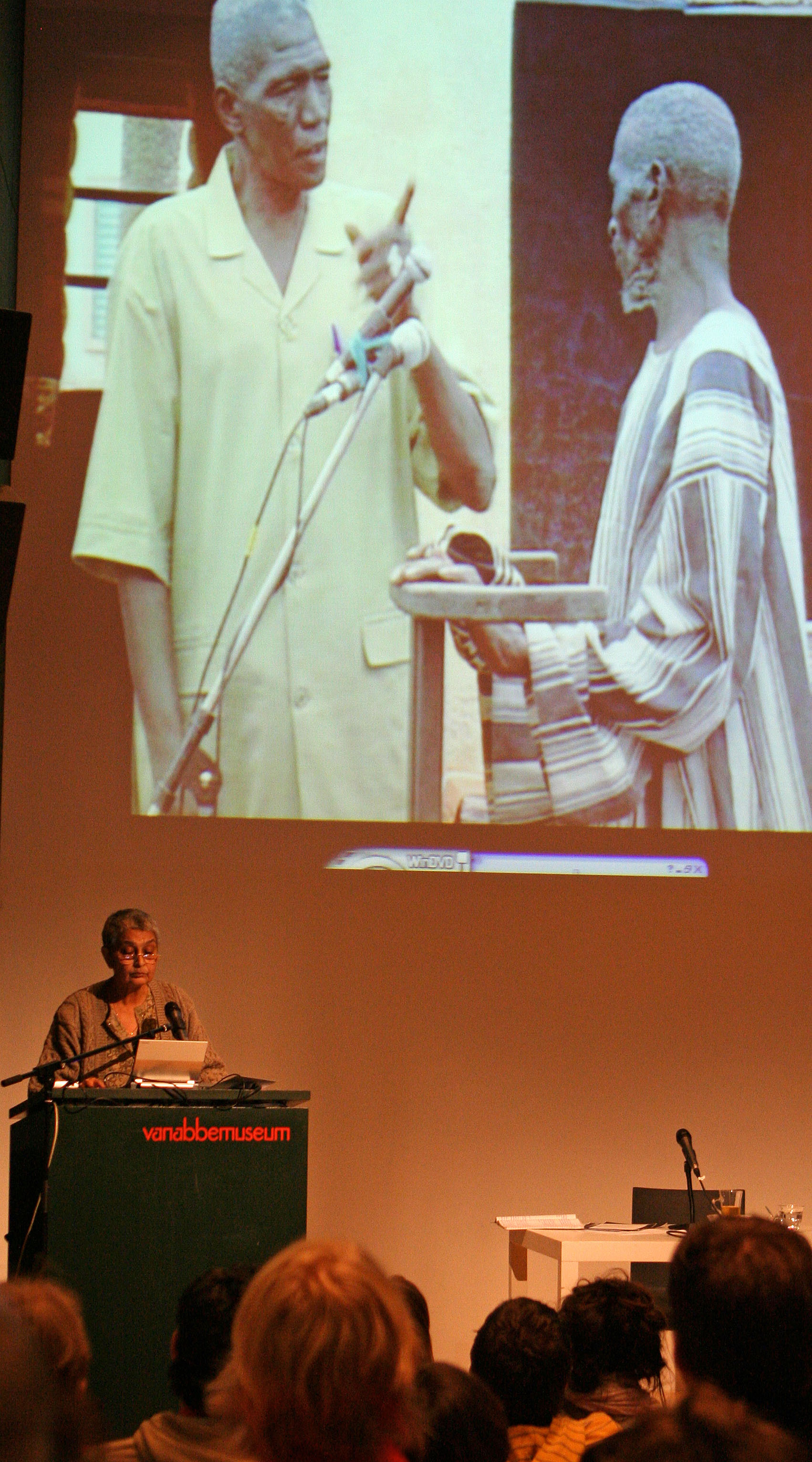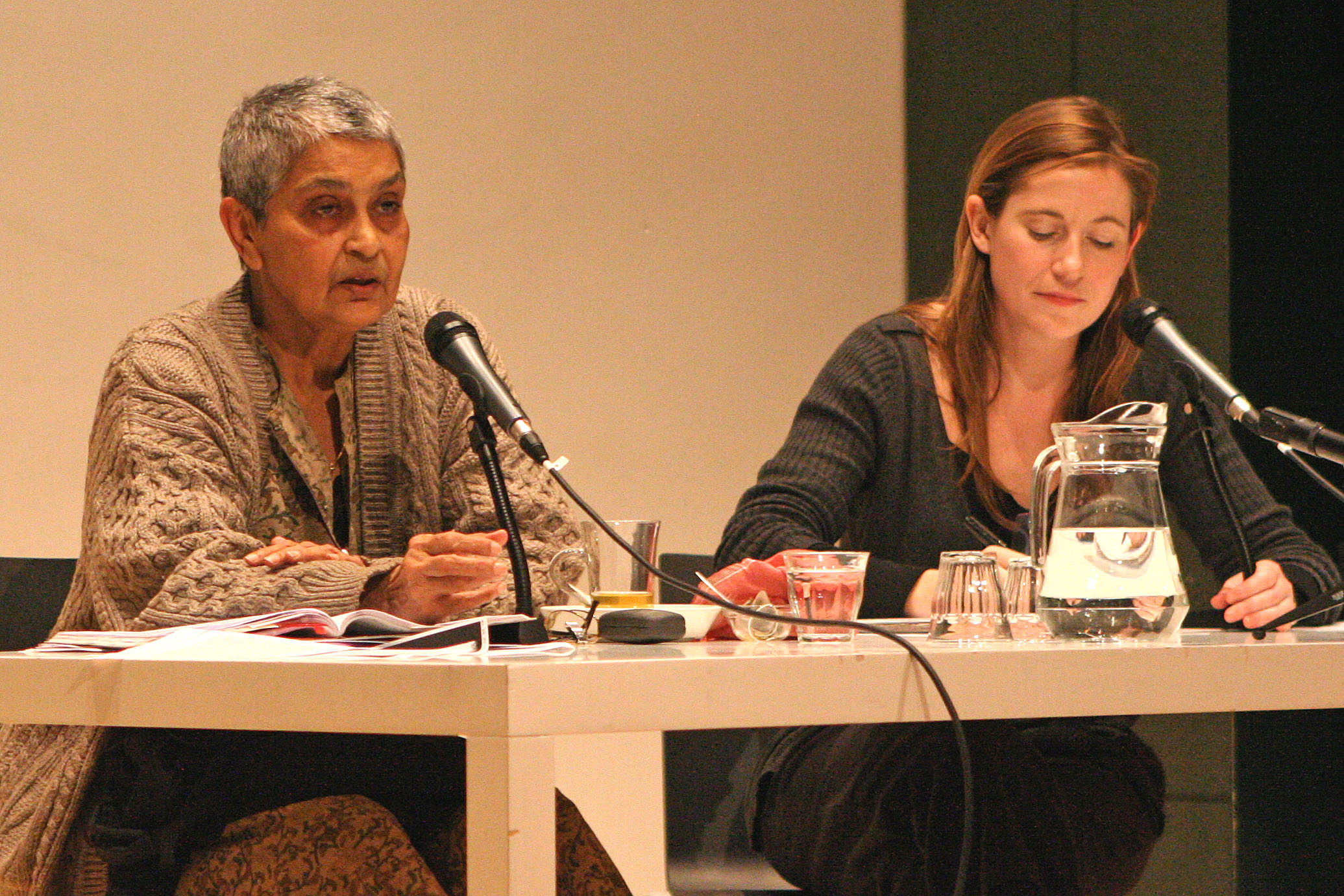 Tonight it’s the very last lecture of the Eindhoven Caucus. There are a few participants and a lot of new faces in the full auditorium. Annie introduces the last speaker, Gayatri Chakravorty Spivak. She is a professor at the Columbia University in New York and will speak about Alter globalization and conceptual art.
Tonight it’s the very last lecture of the Eindhoven Caucus. There are a few participants and a lot of new faces in the full auditorium. Annie introduces the last speaker, Gayatri Chakravorty Spivak. She is a professor at the Columbia University in New York and will speak about Alter globalization and conceptual art.
Gayatri Chakravorty Spivak admits that she is a little bit old fashioned. She has taken a lot of books along and mutters impatiently when she needs to work with the computer. But her speech is not old fashioned. It’s clear that she is used to speaking and teaching to a large crowd. She varies with quotes and pieces of film. After asking if she was the only woman in the caucus, Gayatri Chakravorty Spivak begins with “a dead dog”. She starts literally with a shot about a dead dog in the film Bamako. After that she quotes Kafka and King Lear in which she founds a ‘dead dog theme’. She gives more examples about ‘dead dogs’ in one of the books she brought along and asks if anyone read her work about it. “No one? Good. Ah, only one. Even better.” It’s those little pieces of humour that makes the speech easy to listen to. With using short film shots of the film Bamako, Gayatri Chakravorty Spivak continues about different subjects. She asks the public to pay attention and look for differences and concludes that “the world does not end in a migrant metropolis”. Before opening the floor (“because I only have thirty minutes I hope you will ask me about alter globalization so I can tell more about it”) she says that she sees texts as a weave, not as a verbal. Gayatri Chakravorty Spivak asks if that makes a difference when asking who can access intertextuality. And the dead dog theme? Not present in this lecture. Very alive and kicking, after the first questioners warm up.
One guest is very relieved that Spivak has mentioned that art is untranslatable European. Therefore she asks how Spivak would define the art in the non-western countries. What can one do about it? Spivak admits that she doesn’t really have an answer for this question but that she shares the question. ,,I’m not saying that there is no art, but there are two things I want to make clear. One is the fact that over time words can have different meanings. My mother was fourteen when she married my father and fifteen when she had my brother. This however was not called a teenage pregnancy. You see how this works? Words with a certain meaning now perhaps didn’t even exist then. And second, what is non-western? Are India, the Oceanic and the Asian countries not Western? We live in the shadow of the European enlightenment. You can’t just produce art history.”
Spivak mentioned a story about a women in disgrace and one audience-member wonders if learning from novels is something she would advise. Spivak is quick to say that no, novels are not instructions. ,,King Lear is not an instructor for beheading. When you read a lot of books, you can get the habit of being in other spaces. I don’t want to be told what to do, but I want to read a novel. One should learn a language to be able to read poetry for instance. When one can read poetry, one knows the language. What can we learn from these kind of texts, these books? That is important, not to follow everything the author says, but learn from it.”
 And finally, a question about the dead dog. ,,What is the reading that you wanted to give to us with the dead dog?” ,,That anything could be anything,” Spivak answers. ,,There is no subalternity. It’s a social structure. A way to describe it is anyone who is a victim of racism. Persons who are detached from lines of social ability. It’s not to face an inconvinient truth. One musn’t claim one of these world saving claims, the claim is not for you it is for art itself.”
And finally, a question about the dead dog. ,,What is the reading that you wanted to give to us with the dead dog?” ,,That anything could be anything,” Spivak answers. ,,There is no subalternity. It’s a social structure. A way to describe it is anyone who is a victim of racism. Persons who are detached from lines of social ability. It’s not to face an inconvinient truth. One musn’t claim one of these world saving claims, the claim is not for you it is for art itself.”